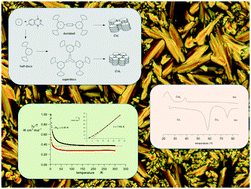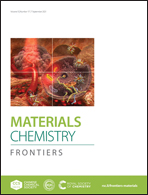Discs, dumbbells and superdiscs: molecular and supermolecular architecture dependent magnetic behavior of mesogenic Blatter radical derivatives†
Abstract
A series of isomeric supermolecular bi-and tri-radicals, in which “half disc” mesogens are connected 1,4- and 1,3,5-through benzene, respectively, are investigated for liquid crystalline (optical, thermal and powder XRD methods) and magnetic properties (SQUID and VT-EPR methods). The results demonstrate diverse phase structures of the bi- and tri-radicals, which self-organize into Colr, Colh, and Colh(3D) phases. Magnetic data revealed intermolecular ferromagnetic interactions in the solid-state only in bi- and tri-radicals with the connection at the C(3) position, for which the Weiss constant θ (7.8 and 5.2 K, respectively; from Curie–Weiss analysis) and J/kB exchange interaction energy (2.74 and 3.14 K, respectively; from Baker thermal expansion analysis) were obtained. Variable temperature EPR data demonstrated an increase of signal intensity in most liquid crystalline phases and continuous increase above the mesophase-isotropic liquid transition in two biradicals. Overall results indicate that the dumbbell shape (biradicals) and connection through the C(3) position are most favorable for mesogenic and non-trivial magnetic properties in the series.



 Please wait while we load your content...
Please wait while we load your content...